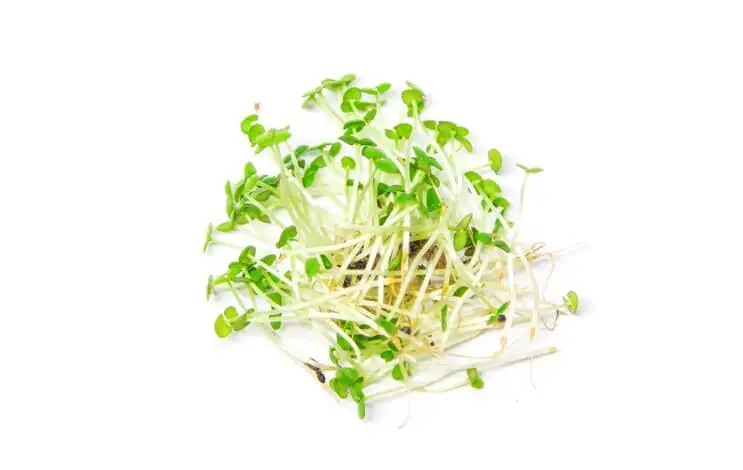Basil Microgreen Nutrition Fact Sheet

Basil microgreens, often overshadowed by their mature counterparts, are tiny nutritional powerhouses deserving of in-depth exploration. Harvested at an early growth stage, these diminutive greens possess a remarkable array of essential nutrients that can profoundly impact health and well-being. In this fact sheet, we will delve deep into the intricate nutritional profile of basil microgreens, supported by scientific references, to uncover the layers of their nutritional excellence and their potential to promote optimal health.
Nutritional Profile
The nutritional composition of basil microgreens per 100 grams reveals a tapestry of essential elements:
Vitamins: Basil microgreens are notably rich in vitamin K, a critical factor in blood clotting and bone health. Additionally, they provide substantial quantities of vitamin A, supporting immune function and skin integrity, and vitamin C, a potent antioxidant vital for cellular protection.
Minerals: These microgreens offer a treasury of essential minerals, including calcium, potassium, magnesium, and iron. Calcium fortifies skeletal integrity, potassium regulates blood pressure, magnesium fosters neuromuscular function, and iron facilitates oxygen transport.
Phytonutrients: Basil microgreens are teeming with phytonutrients, such as flavonoids and polyphenols, revered for their potent antioxidant and anti-inflammatory properties. These compounds act as sentinels, guarding against chronic diseases and promoting long-term well-being.
Fiber: Although present in modest amounts compared to some greens, basil microgreens contribute to digestive health through their fiber content, fostering a resilient and balanced gut environment.
Health Benefits
Antioxidant Vigor: Basil microgreens shine as antioxidants, forming a formidable defense against free radicals implicated in chronic diseases. The synergy of vitamins A and C, coupled with phytonutrients, fortifies the body’s innate protective mechanisms.
Anti-Inflammatory Efficacy: The anti-inflammatory constituents of basil microgreens offer respite from the symptoms of various inflammatory conditions, from arthritis to allergies, enhancing overall comfort and vitality.
Cardiovascular Resilience: Potassium and magnesium content ensures cardiovascular robustness by regulating blood pressure and mitigating heart-related risks.
Skeletal Integrity: Abundant vitamin K content in basil microgreens fosters calcium absorption, underpinning bone health and ensuring sturdy skeletal structures.
Weight Management Ally: Basil microgreens, with their low-calorie content and fiber richness, promote satiety and prudent calorie consumption, rendering them invaluable companions in weight management endeavors.
Digestive Wellness: Although their fiber content may not be as prominent as that of some other greens, basil microgreens nonetheless contribute to digestive well-being by nurturing a balanced gut environment and alleviating common digestive discomforts.
Basil microgreens, often relegated to obscurity, possess a multifaceted nutritional richness that merits the spotlight. Their intricate vitamin, mineral, and phytonutrient composition, coupled with their myriad health benefits, underscore their significance in fostering overall well-being and a healthier lifestyle. Embrace the depths of nutritional excellence that basil microgreens offer to unlock their full potential and embark on a journey toward a life marked by vitality and optimal health.
References
Aaron, K. J., & Sanders, P. W. (2013). Role of dietary salt and potassium intake in cardiovascular health and disease: A review of the evidence. Mayo Clinic Proceedings. Mayo Clinic, 88(9), 987–995. https://doi.org/10.1016/j.mayocp.2013.06.005
Booth, S. L. (2009). Roles for vitamin K beyond coagulation. Annual Review of Nutrition, 29(1), 89–110. https://doi.org/10.1146/annurev-nutr-080508-141217
Carr, A., & Maggini, S. (2017). Vitamin C and immune function. Nutrients, 9(11), 1211. https://doi.org/10.3390/nu9111211
Geleijnse, J. M., Grobbee, D. E., & Kok, F. J. (2005). Impact of dietary and lifestyle factors on the prevalence of hypertension in Western populations. Journal of Human Hypertension, 19(S3), S1–S4. https://doi.org/10.1038/sj.jhh.1001953
Hurrell, R., & Egli, I. (2010). Iron bioavailability and dietary reference values. The American Journal of Clinical Nutrition, 91(5), 1461S-1467S. https://doi.org/10.3945/ajcn.2010.28674f
Makki, K., Deehan, E. C., Walter, J., & Bäckhed, F. (2018). The impact of dietary fiber on gut Microbiota in host health and disease. Cell Host & Microbe, 23(6), 705–715. https://doi.org/10.1016/j.chom.2018.05.012
Manach, C., Scalbert, A., Morand, C., Rémésy, C., & Jiménez, L. (2004). Polyphenols: food sources and bioavailability. The American Journal of Clinical Nutrition, 79(5), 727–747. https://doi.org/10.1093/ajcn/79.5.727
Sica, D. A., Struthers, A. D., Cushman, W. C., Wood, M., Banas, J. S., Jr, & Epstein, M. (2002). Importance of potassium in cardiovascular disease. Journal of Clinical Hypertension (Greenwich, Conn.), 4(3), 198–206. https://doi.org/10.1111/j.1524-6175.2002.01728.x
Sies, H., Berndt, C., & Jones, D. P. (2017). Oxidative stress. Annual Review of Biochemistry, 86(1), 715–748. https://doi.org/10.1146/annurev-biochem-061516-045037
Christofi, A., Margariti, G., Salapatas, A., Papageorgiou, G., Zervas, P., Karampiperis, P., Koukourikos, A., Tarantilis, P. A., Kaparakou, E. H., Misiakos, K., & Makarona, E. (2023). Determining the nutrient content of hydroponically-cultivated microgreens with immersible silicon photonic sensors: A preliminary feasibility study. Sensors (Basel, Switzerland), 23(13), 5937. https://doi.org/10.3390/s23135937
Disclaimer: The information provided in this article is for educational and informational purposes only and is not intended as medical advice. It is not a substitute for professional medical advice, diagnosis, or treatment. Always seek the advice of a qualified healthcare provider with any questions you may have regarding a medical condition. The author and publisher of this article are not responsible for any adverse effects or consequences resulting from the use of any suggestions, preparations, or procedures described in this article.

